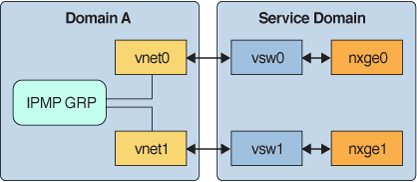Configuring Virtual Network Devices Into an IPMP Group in an Oracle Solaris 10 Domain
Two Virtual Networks Connected to Separate Virtual Switch Instances (Oracle Solaris 10) shows two virtual networks (vnet0 and vnet1) connected to separate virtual switch instances (vsw0 and vsw1) in the service domain, which in turn use two different physical interfaces. The physical interfaces are nxge0 and nxge1 in the Oracle Solaris 10 service domain.
If a physical link failure occurs in the service domain, the virtual switch device that is bound to that physical device detects the link failure. Then, the virtual switch device propagates the failure to the corresponding virtual network device that is bound to this virtual switch. The virtual network device sends notification of this link event to the IP layer in the guest domain A, which results in failover to the other virtual network device in the IPMP group.
Figure 19 Two Virtual Networks Connected to Separate Virtual Switch Instances (Oracle Solaris 10)

Virtual Network Devices Each Connected to Different Service Domains (Oracle Solaris 10) shows that you can achieve further reliability in the logical domain by connecting each virtual network device (vnet0 and vnet1) to virtual switch instances in different service domains. In this case, in addition to physical network failure, guest domain A can detect virtual network failure and trigger a failover following a service domain crash or shutdown.
Figure 20 Virtual Network Devices Each Connected to Different Service Domains (Oracle Solaris 10)

For more information, see Oracle Solaris Administration: IP Services.